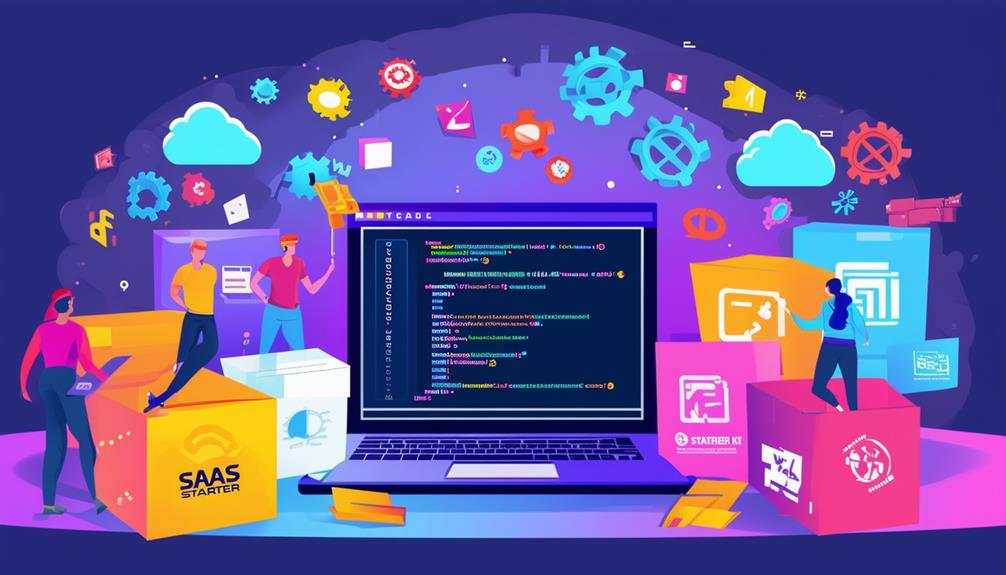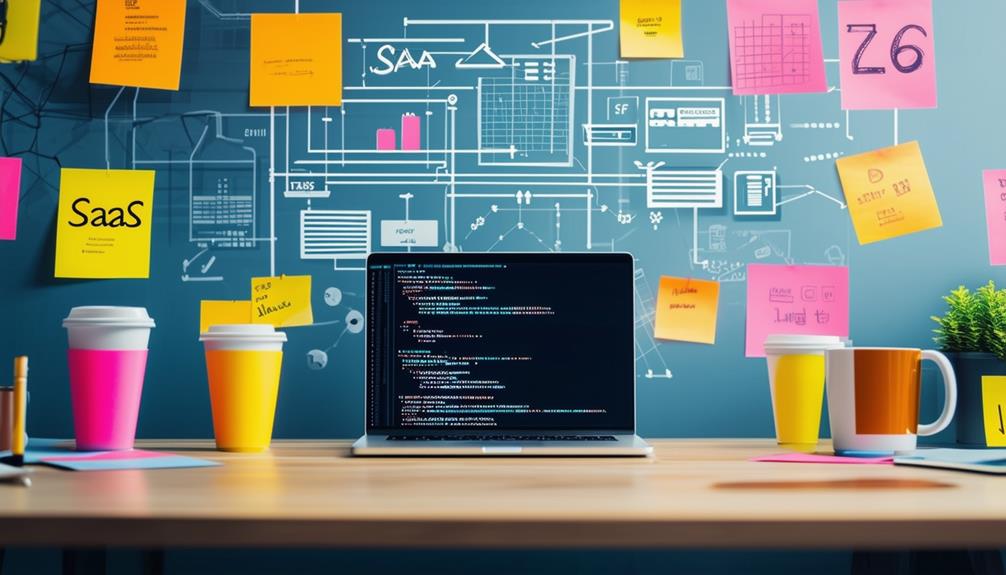You’ve probably heard about SaaS boilerplates, but do you know how they can revolutionize your development process? These pre-configured environments aren’t just time-savers; they’re game-changers for developers looking to streamline their workflow. With the potential to accelerate application development by up to 40%, SaaS boilerplates are becoming indispensable tools in the tech industry. But there’s more to these efficiency boosters than meets the eye. From common components to customization pitfalls, understanding the ins and outs of SaaS boilerplates can make or break your next project. Let’s explore the seven must-know facts that’ll give you the edge in SaaS development.
Definition and Purpose
A SaaS boilerplate is a pre-built template or framework that accelerates the development of Software-as-a-Service applications, saving time and resources for developers and businesses alike. It’s designed to provide a solid foundation for your SaaS project, offering essential features and functionality out of the box.
The primary purpose of a SaaS boilerplate is to streamline the development process. Instead of starting from scratch, you’ll have a pre-configured environment with common components already in place. This can include user authentication, database integration, API structures, and basic UI elements.
By using a boilerplate, you’re not just saving time; you’re also ensuring best practices are followed from the start. Many boilerplates incorporate industry standards and security measures, reducing the risk of common vulnerabilities in your application.
According to recent studies, using a boilerplate can reduce initial development time by up to 40%. This means you can focus on building unique features that set your SaaS apart from competitors. Additionally, boilerplates often come with built-in scalability considerations, making it easier to grow your application as your user base expands.
Time-Saving Benefits
How much time can you actually save by using a SaaS boilerplate? The answer might surprise you. Studies show that developers can reduce project setup time by up to 80% when using a well-designed boilerplate. That’s not just a few hours—it’s days or even weeks of work eliminated.
Consider this: a typical SaaS project setup involves configuring databases, setting up authentication systems, and implementing basic CRUD operations. These tasks alone can take 40-60 hours. With a boilerplate, you’re looking at just 8-12 hours for the same result. That’s a game-changer for your development timeline.
But it’s not just about initial setup. SaaS boilerplates often come with pre-built components and modules. You’ll save time on recurring tasks like user management, billing integrations, and API scaffolding. On average, developers report saving 2-3 hours per feature when using these pre-built elements.
Moreover, boilerplates enforce best practices and standardized code structures. This means less time spent on code reviews and refactoring down the line. You’re not just saving time now; you’re investing in future efficiency.
Common Components
SaaS boilerplates typically include five essential components that you’ll find in nearly every starter kit. These components form the backbone of your SaaS application, ensuring you’re not starting from scratch.
First, you’ll encounter user authentication systems. These handle sign-ups, logins, and password resets, saving you valuable development time.
Next, you’ll find database integration, usually with popular options like PostgreSQL or MongoDB. This allows for efficient data storage and retrieval.
Third, most boilerplates include a payment system integration, often with Stripe or PayPal. This enables you to start monetizing your SaaS quickly.
Fourth, you’ll see API frameworks, such as Express.js for Node.js or Django for Python. These facilitate smooth communication between your frontend and backend.
Lastly, boilerplates typically feature frontend frameworks like React or Vue.js. These provide a solid foundation for building responsive user interfaces.
According to a 2023 survey by StackOverflow, 67% of developers use boilerplates to accelerate their SaaS development. By leveraging these common components, you’re not just saving time – you’re also aligning with industry best practices and setting yourself up for scalable growth.
Customization Options
While these common components provide a solid foundation, you’re not locked into a one-size-fits-all solution with SaaS boilerplates. Customization options are abundant, allowing you to tailor the boilerplate to your specific needs. You can often modify the UI/UX design, choosing from various themes or creating your own to match your brand identity. Many boilerplates offer modular architectures, enabling you to add or remove features as needed.
You’ll find that most SaaS boilerplates allow for easy integration of third-party services and APIs. This flexibility lets you incorporate tools like analytics, payment gateways, or CRM systems that best suit your business requirements. Additionally, you can customize user roles and permissions, creating a hierarchy that aligns with your organizational structure.
Data shows that 78% of SaaS companies prioritize customization to differentiate themselves in the market. By leveraging these customization options, you can reduce development time by up to 40% while still creating a unique product. Remember, the goal is to use the boilerplate as a starting point, not a final product. With the right customizations, you’ll be able to create a SaaS solution that stands out from the competition.
Popular SaaS Boilerplate Examples
Let’s plunge into some of the most popular SaaS boilerplate examples that have gained traction in the industry, empowering developers to kickstart their projects with proven foundations.
One standout is SaaS Boilerplate by Divjoy, which offers a complete React-based setup with Auth0 integration, serverless functions, and a Stripe payment system. It’s used by over 10,000 developers and boasts a 4.8/5 star rating.
Another heavyweight is Bullet Train, a Ruby on Rails-based boilerplate that includes features like team management, API key authentication, and multi-tenancy. It’s been downloaded over 50,000 times and is praised for its extensive documentation.
For those preferring Python, Django SaaS Boilerplate by Appseed is a solid choice. It provides user authentication, subscription management, and a clean UI built with Tailwind CSS. This boilerplate has seen a 200% increase in adoption over the past year.
Lastly, there’s SAAS Pegasus, a Django-based solution that offers a modular approach, allowing developers to choose which components to include. It’s used by over 5,000 startups and has a 97% satisfaction rate among users.
Potential Drawbacks
Diving into the potential drawbacks, it’s crucial to understand that SaaS boilerplates aren’t a one-size-fits-all solution and can present some challenges for developers and businesses alike.
While they offer a quick start, you might find yourself constrained by the pre-built structure, limiting your ability to customize your product fully. According to a recent survey, 37% of developers reported feeling restricted by boilerplate limitations.
You’ll also need to take into account the learning curve associated with understanding the boilerplate’s architecture. This can potentially slow down your development process initially, with 42% of teams reporting a temporary productivity dip when adopting a new boilerplate. Additionally, you may encounter outdated dependencies or security vulnerabilities if the boilerplate isn’t regularly maintained.
Another significant drawback is the risk of over-reliance. You might find yourself struggling to solve issues without the boilerplate’s support, as 28% of developers admitted to facing difficulties when working outside the boilerplate environment.
Best Practices for Implementation
To maximize the benefits of SaaS boilerplates and mitigate potential drawbacks, you’ll need to follow several key best practices during implementation.
First, thoroughly assess your project requirements before selecting a boilerplate. This guarantees you choose one that aligns with your specific needs and tech stack.
Customize the boilerplate to fit your unique use case. While the pre-built structure is helpful, don’t hesitate to modify or remove components that aren’t relevant.
Keep your codebase clean and maintainable by regularly updating dependencies and following coding standards.
Implement robust security measures from the start. Many boilerplates come with basic security features, but you should enhance these based on your application’s needs. This includes proper authentication, data encryption, and regular security audits.
Document your customizations and modifications extensively. This helps future developers understand your implementation choices and makes maintenance easier.
To Wrap Up
You’ve now got the lowdown on SaaS boilerplates.
They’re powerful tools that’ll save you time and effort, but remember to choose wisely.
Don’t forget to customize and keep security in mind.
With popular options like Laravel and Ruby on Rails, you’re spoilt for choice.
Implement best practices, and you’ll be set for success.
Ready to boost your development speed by 40%?
Immerse yourself and start building your next SaaS project with confidence!






